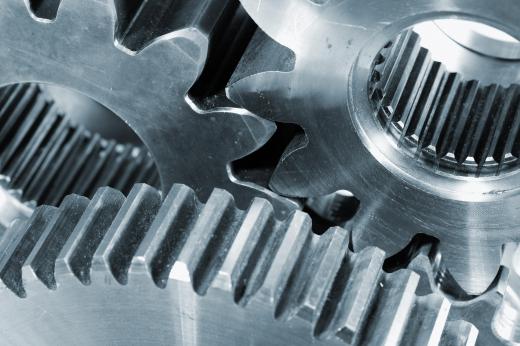At AboutMechanics, we're committed to delivering accurate, trustworthy information. Our expert-authored content is rigorously fact-checked and sourced from credible authorities. Discover how we uphold the highest standards in providing you with reliable knowledge.
What is a Gear Ratio?
A gear ratio is the relationship between the number of teeth on two gears which are meshed. This relationship is expressed mathematically. For example, if one gear with 13 teeth is driven by a gear with 21 teeth, the gear ratio is 1/1.62, or 1:1.62. Almost all types of mechanical machinery, such as vehicles, farm equipment, and industrial machines, use gears in some way, and gear ratios are used to help define the machine’s performance.
The idea of a gear ratio is based on the circumference of circles. When two gears with different circumferences are connected by teeth on the outer edge, the movement of the one is translated into greater or lesser movement by the other. If a gear with a large circumference is turning one that is only half as big, the smaller gear will spin twice as fast as the larger one. The same concept works in reverse.

Gear ratios are specifically tailored by manufacturers of engines and other machinery, to achieve a certain result. In some contexts, such as automobile transmissions, gear ratios can be varied to adapt to the car’s needs at different rates of speed. The lowest gear in a car’s transmission will have a high gear ratio, such as 2:1 or 3:1. This gives the car the ability to easily start moving from a complete stop, such as at a traffic light. However, since the engine has to make two or three revolutions for every revolution of the transmission, an engine cannot make a car in low gear go very fast.
In second gear, the gear ratio is lower, meaning that the engine does not have to work as hard to give the car additional acceleration. In the higher gears, the gear ratios get progressively lower. These are good for moderate acceleration and reducing the number of engine revolutions needed to keep the car at a comfortable cruising speed. The gears in a transmission, therefore, serve to either magnify or reduce the output of an engine, based on the car’s speed at the time.
Gears can sometimes be connected by belts or in other ways, but most are connected by teeth. This arrangement provides some distinct advantages. First, as long as none of the teeth break, there is no slippage between the gears, which would result in a loss of efficiency. They also make it possible to design exact gear ratios. Even if the circumferences of the gears are slightly imperfect, the teeth make it so that these imperfections don’t matter. Since they exactly synchronize the gears, they also give them an exact gear ratio.
AS FEATURED ON:
AS FEATURED ON:











Discussion Comments
what is the use of finding the gear ratio?
Post your comments